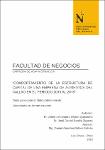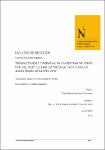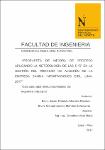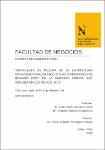Mostrar el registro sencillo del ítem
Comportamiento de la estructura de capital de una empresa de alimentos del Callao en el periodo 2010 al 2015
| dc.contributor.advisor | Robles Fabián, Daniel Amadeo | |
| dc.contributor.author | Osorio Quijandria, Alberto Alejandro | |
| dc.contributor.author | Bonilla Zegarra, José Daniel | |
| dc.date.accessioned | 2019-03-05T20:43:46Z | |
| dc.date.available | 2019-03-05T20:43:46Z | |
| dc.date.issued | 2018-12-19 | |
| dc.identifier.citation | Osorio, A. A. & Bonilla, J. D. (2018). Comportamiento de la estructura de capital de una empresa de alimentos del Callao en el periodo 2010 al 2015 (Tesis de licenciatura). Repositorio de la Universidad Privada del Norte. Recuperado de http://hdl.handle.net/11537/15016 | es_PE |
| dc.identifier.other | 658.15 OSOR 2018 | es_PE |
| dc.identifier.uri | https://hdl.handle.net/11537/15016 | |
| dc.description.abstract | RESUMEN El uso de la teoría que se realiza en el presente documento tiene como finalidad describir el comportamiento de la estructura de capital de la empresa de alimentos del Callao en Perú durante el periodo de evaluación del 2010 al 2015, si presenta un comportamiento acorde a como lo describe la teoría del Trade Off; y, si presenta una estructura óptima de capital, aplicando el modelo de López y De Luna; o el Pecking Order de Myers, que explica una jerarquía de selección sobre qué primero usan las empresas para financiar sus proyectos eliminando la idea de que existe una estructura óptima de capital. Además, describir la teoría correspondiente que complementa a ambos campos de la estructura de capital, desarrolladas durante los últimos 50 años, desde lo expuesto por Miller y Modigliani hasta las más contemporáneas como lo es la teoría de agencias, teoría de las señales, de asimetría de información. Esta investigación ha sido dividida en capítulos que expresan lo siguiente: Capítulo 1 – Introducción: Se presenta un breve alcance acerca de cómo se encuentra la situación teórica de la estructura de capital y cómo esta se relaciona directamente con la creación de valor en las empresas a nivel global, para luego entrar en el mercado local, presentando cómo ha sido el comportamiento del nivel de endeudamiento a nivel nacional. Así optando por escoger de las empresas que cotizan en la Bolsa de Valores de Lima. Esta empresa de Alimentos como fuente para el presente estudio sobre el comportamiento de la estructura de capital. Capítulo 2 – Marco Teórico: Se presenta el contenido de las teorías que explican y brindan fundamento para la estructura de capital, y cómo estas bajo supuestos expuestos en cada una de ellas, pretenden explicar el comportamiento de las empresas de si tienen o no la tendencia a seleccionar una estructura óptima de capital. Además, se expone lo correspondiente a los periodos de estudio y la situación financiera de la empresa de alimentos. Capítulo 3 – Variables: Expone el contenido de la operacionalización de la variable en estudio, de manera que permite establecer cómo el objetivo de la investigación tiene concordancia con los resultados obtenidos del estudio de la empresa de alimentos del Callao. Capítulo 4 – Materiales y Métodos: Se realiza una investigación descriptiva no experimental y transversal para la variable en estudio, además de presentar la forma en cómo hemos obtenido la información de la empresa en estudio y con qué metodología vamos a evaluar dicha información. Capítulo 5 – Resultados: Habiendo presentado la metodología se desarrolla y presenta los resultados obtenidos. Para concluir, queda en los lectores del presente trabajo en darle el uso que mejor le fuere conveniente, con el deseo que nuestro trabajo haya sido de ayuda para ampliar el conocimiento sobre los distintos conceptos tocados y permita motivarles para continuar con el estudio de este tema en el mercado peruano. | es_PE |
| dc.description.abstract | ABSTRACT The objective of the theory presented in this document is the behavior of the structure of the capital of the Callao food company in Peru during the evaluation period from 2010 to 2015, and that it behaves according to how to Describe the Trade-Off theory; and, if it presents an optimal capital structure, applying the López and De Luna model; or Myers' Pecking Order, which explains a hierarchy of selection on what to do for companies to finance their projects to eliminate the idea that there is an optimal capital structure. In addition, to describe the corresponding theory that complements both fields of the capital structure developed during the last 50 years, from what was exposed by Miller and Modigliani to the most contemporary such as agency theory, sign theory, asymmetrical information. This research has been divided into chapters that express the following: Chapter 1 - Introduction: A brief outline is presented on how the theoretical situation of the capital structure is found and how it relates directly to the creation of value in companies at a global level, then entering the local market, presenting as has been the behavior of the level of indebtedness at the national level. Thus, choosing to choose from companies listed on the Lima Stock Market, This food company as a source for the present study on the behavior of the capital structure. Chapter 2 - Theoretical Framework: It presents the content of theories that explain and provide a foundation for the capital structure, and as these under assumptions exposed in each of them, try to explain the behavior of companies whether or not they have the trend to select an optimal capital structure. In addition, it is exposed to the periods of study and the financial situation of the food company. Chapter 3 - Hypothesis: It exposes the content of the operationalization of the variable under study, in a way that allows establishing how the objective of the investigation is in agreement with the results obtained from the study of the food company. Chapter 4 - Materials and Methods: A non-experimental and cross-sectional descriptive research was performed for the variable under study, as well as how we obtained the information of the company under study and with which methodology we are going to evaluate this information. Chapter 5 - Results: Having presented the methodology, the results obtained are developed and displayed. In conclusion, it is left to the readers of this work to give it the use that is best for them, with the desire that our work has been of help to broaden the knowledge about the different concepts touched and to motivate them to continue the study of this subject In the Peruvian market. | es_PE |
| dc.description.uri | Tesis | es_PE |
| dc.format | application/pdf | es_PE |
| dc.format | application/msword | es_PE |
| dc.language.iso | spa | es_PE |
| dc.publisher | Universidad Privada del Norte | es_PE |
| dc.rights | info:eu-repo/semantics/openAccess | es_PE |
| dc.rights.uri | https://creativecommons.org/licenses/by-nc-sa/2.5/pe/ | * |
| dc.source | Universidad Privada del Norte | es_PE |
| dc.source | Repositorio Institucional - UPN | es_PE |
| dc.subject | Estrés laboral | es_PE |
| dc.subject | Calidad total | es_PE |
| dc.subject | Control interno | es_PE |
| dc.title | Comportamiento de la estructura de capital de una empresa de alimentos del Callao en el periodo 2010 al 2015 | es_PE |
| dc.type | info:eu-repo/semantics/bachelorThesis | es_PE |
| thesis.degree.grantor | Universidad Privada del Norte. Facultad de Negocios | es_PE |
| thesis.degree.level | Título Profesional | es_PE |
| thesis.degree.discipline | Administración | es_PE |
| thesis.degree.name | Licenciado en Administración | es_PE |
| dc.publisher.country | PE | es_PE |
| dc.subject.ocde | https://purl.org/pe-repo/ocde/ford#5.02.04 | es_PE |
| thesis.degree.program | Pregrado | es_PE |
| dc.description.sede | Los Olivos | es_PE |
| renati.discipline | 413016 | es_PE |
| renati.level | https://purl.org/pe-repo/renati/level#tituloProfesional | es_PE |
| renati.type | https://purl.org/pe-repo/renati/type#tesis | es_PE |
Ficheros en el ítem
Este ítem aparece en la(s) siguiente(s) colección(ones)
-
Tesis [1650]







